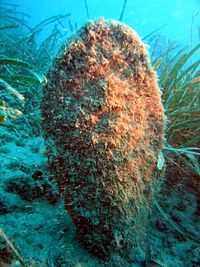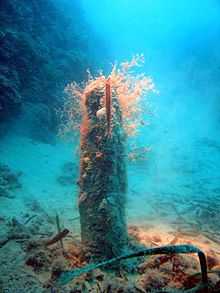Pinna nobilis
| Pinna nobilis | |
|---|---|
 | |
| Live specimen of Pinna nobilis, in Levanto, Liguria (Italy) | |
| Scientific classification | |
| Kingdom: | Animalia |
| Phylum: | Mollusca |
| Class: | Bivalvia |
| Order: | Pterioida |
| Family: | Pinnidae |
| Genus: | Pinna |
| Species: | P. nobilis |
| Binomial name | |
| Pinna nobilis Linnaeus, 1758 | |
| Synonyms | |
|
Pinna gigas Chemnitz | |
Pinna nobilis, common name the noble pen shell or fan mussel, is a large species of Mediterranean clam, a marine bivalve mollusc in the family Pinnidae, the pen shells. It reaches up to 120 cm (4 ft) of shell length.[1]
Description

The bivalve shell is usually 30–50 cm (1.0–1.6 ft) long,[2] but can reach 120 cm (4 ft).[1] Its shape differs depending on the region it enhabitates. Like all pen shells it is relatively fragile to pollution and shell damage. It attaches itself to rocks using a strong byssus composed of many silk-like threads which used to be made into cloth. These keratin fibres that the animal secretes by byssus gland are even 6 cm (2.4 in) long. The inside of the shell is lined with brilliant mother-of-pearl.[3]
Distribution
This species is endemic to the Mediterranean Sea, where it lives offshore at depths ranging between 0.5 and 60 m (1.6 and 196.9 ft).[4] It could be found buried beneath soft-sediment areas (fine sand, mud, often anoxic).[5]
Human relevance
This species is the origin of sea silk, which was made from the byssus of the animal.[6]
In recent years, Pinna nobilis has become threatened with extinction, due in part to fishing, incidental killing by trawling and anchoring, and the decline in seagrass fields; pollution kills eggs, larvae, and adult mussels.[7] The noble pen shell has been listed as an endangered species in the Mediterranean Sea. The European Council Habitats Directive 92/43/EEC, on conservation of natural habitats and the wild fauna and flora, proclaims that P. nobilis is strictly protected (by the Annex IV of EEC, 1992)- all forms of deliberate capture or killing of fan mussel specimens are prohibited by law.[8]
As part of the Costa Concordia disaster recovery effort ongoing in Italy (2012), a group of about 200 Pinna nobilis were manually relocated to a nearby area due to the threat posed by subsequent engineering work.[9]
Gallery
-

Live specimen of P. nobilis, looking into the shell from above
-
Pinna nobilis: shell and byssus
-
The very fine byssus threads of P. nobilis
-

Shell of Pinna nobilis
Footnotes
- ↑ 1.0 1.1 (Zavodnik, Hrs-Brenko, & Legac, 1991)
- ↑ Acquario di Genova (2006). Pinna nobilis. Retrieved 15 September 2014.
- ↑ Tyndale (1849), pp. 77–79.
- ↑ (Butler, Vicente, & De Gaulejac, 1993)
- ↑ (Centoducati et al, 2006)
- ↑ Hill (2009), pp. 468–476.
- ↑ Hill (2009), pp. 468–476.
- ↑ (Centoducati et al, 2006)
- ↑ Reuters video about the Pinna nobilis relocation
See also
References
- Butler, A., Vicente, N., De Gaulejac, B. (1993). Ecology of the pteroid bivalves P. nobilis bicolor Gmelin and P. nobilis L. Marine Life, 3(1-2), 37-45.
- Centoducati, G., Tarsitano, E., Bottalico, A., Marvulli, M., Lai, O., Crescenzo, G. (2006). Monitoring of the Endangered Pinna nobilis Linee, 1758 in the Mar Grande of Taranto (Ionian Sea, Italy). In the Environ Monit Assess (2007) 131:339-347.
- Hill, John E. (2009) Through the Jade Gate to Rome: A Study of the Silk Routes during the Later Han Dynasty, 1st to 2nd centuries CE. John E. Hill. BookSurge, Charleston, South Carolina. ISBN 978-1-4392-2134-1. See Section 12 plus "Appendix B – Sea Silk".
- Hill, John E. 2004. The Peoples of the West. A draft annotated translation of the 3rd century Weilüe – see Section 12 of the text and Appendix D.
- Laufer, Berthold. 1915. "The Story of the Pinna and the Syrian Lamb", The Journal of American Folk-lore 28.108:103–128.
- McKinley, Daniel L. 1988. "Pinna and Her Silken Beard: A Foray Into Historical Misappropriations". Ars Textrina: A Journal of Textiles and Costumes, Vol. Twenty-nine, June 1998, Winnipeg, Canada. pp. 9–223.
- Maeder, Felicitas 2002. "The project Sea-silk – Rediscovering an Ancient Textile Material." Archaeological Textiles Newsletter, Number 35, Autumn 2002, pp. 8–11.
- Maeder, Felicitas, Hänggi, Ambros and Wunderlin, Dominik, Eds. 2004. Bisso marino : Fili d’oro dal fondo del mare – Muschelseide : Goldene Fäden vom Meeresgrund. Naturhistoriches Museum and Museum der Kulturen, Basel, Switzerland. (In Italian and German).
- Schafer, Edward H. 1967. The Vermillion Bird: T'ang Images of the South. University of California Press.
- Turner, Ruth D. and Rosewater, Joseph 1958. "The Family Pinnidae in the Western Atlantic" Johnsonia, Vol. 3 No. 38, 28 June 1958, pp. 285–326.
- R. Tucker Abbott & S. Peter Dance, 1982, “Compendium of seashells: a color guide to more than 4,200 of the world’s marine shells”, E.P. Dutton Inc., New York. ISBN 0-525-93269-0.
- Tyndale (1849): The Island of Sardinia, including Pictures of the Manners and Customs of the Sardinians, . . . Three Volumes. John Warre Tyndale. London: Richard Bentley.
- Zavodnik, D., Hrs-Brenko, M., & Legac, M. (1991). Synopsis of the fan shell P. nobilis L. in the eastern Adriatic sea. In the C. F. Boudouresque, M. Avon, & V. Gravez (Eds.), Les Especes Marines a Proteger en Mediterranee (pp. 169–178). Marseille, France: GIS Posidonie publ.